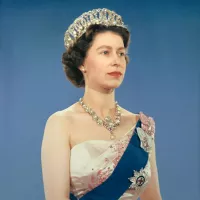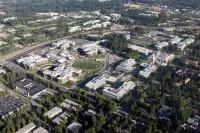The London Stock Exchange (LSE), located in London, is a major global stock exchange with a total market value of US$3.42 trillion as of July 2024. Part of the London Stock Exchange Group since 2007, it remained the most valued stock exchange in Europe as of 2023, despite some post-Brexit challenges. Approximately 12-15% of UK residents/British adults have investments in stocks and shares.
January 1915: Reopening with Restrictions
On 4 January 1915, the Exchange reopened with restrictions, requiring transactions to be in cash only.
November 1918: Peace Returns
When peace returned in November 1918, the mood on the trading floor was generally subdued.
1923: Coat of Arms Received
In 1923, the Exchange received its own coat of arms, with the motto Dictum Meum Pactum, meaning My Word is My Bond.
1937: Plans for a New War
In 1937, officials at the Exchange used their experiences from World War I to create plans for handling a new war, including concerns about air raids.
September 1939: Exchange Closes and Reopens
On the first day of September 1939, the Exchange closed until further notice due to World War II. However, unlike the previous war, it reopened six days later on 7 September.
December 1940: The Great Fire
On the night of 29 December 1940, during one of the greatest fires in London's history, the Exchange's floor was hit by incendiary bombs, but they were quickly extinguished. Trading was done mostly over the phone due to the low volume and air raid danger.
1945: Closure Due to Rocket Damage
In 1945, the Exchange closed for one day due to damage from a V-2 rocket during wartime, although trading continued in the basement.
1967: Work Begins on the New Stock Exchange Tower
Work on the new Stock Exchange Tower began in 1967.
November 1972: New Stock Exchange Tower Opening
On 8 November 1972, Queen Elizabeth II opened the new Stock Exchange Tower, a 26-storey building with a 23,000 sq ft trading floor.
1973: Changes to the Stock Exchange
1973 marked changes for the Stock Exchange with two trading prohibitions being abolished, admitting women and foreign-born members. In March 1973, the London Stock Exchange merged with eleven British and Irish regional exchanges, creating the CEO position, filled by Robert Fell.
January 1984: FTSE 100 Index Launch
On 3 January 1984, the FTSE 100 Index was launched by a partnership of the Financial Times and the Stock Exchange, tracking the 100 leading companies listed on the Exchange.
1986: Big Bang Deregulation
In 1986, the UK financial markets experienced a sudden deregulation known as the "Big Bang", which included abolishing fixed commission charges and the distinction between stockjobbers and stockbrokers, as well as transitioning to electronic trading.
July 1990: IRA Bombing
On 20 July 1990, a bomb planted by the Provisional Irish Republican Army (IRA) exploded at the Exchange, causing damage but no injuries due to a warning call.
1991: Governance Changes
In 1991, the governing Council of the Exchange was replaced by a board of directors, and the trading name became "The London Stock Exchange".
1992: Visitor's Gallery Closure
In 1992, the Exchange's visitor gallery was permanently closed due to the increasing shift towards electronic trading platforms.
1995: Launch of AIM
In 1995, the Exchange launched the Alternative Investment Market, the AIM, to allow growing companies to expand into international markets.
October 1997: Introduction of SETS
In October 1997, the previous system, SETS, was introduced.
May 2000: Merger Announcement
On 3 May 2000, it was announced that the LSE would merge with the Deutsche Börse; however this fell through.
2000: Became a Public Limited Company
In 2000, the LSE's shareholders voted to become a public limited company, named London Stock Exchange plc. The LSE also transferred its role as the United Kingdom's listing authority to the Financial Services Authority.
2003: Creation of EDX London
In 2003, EDX London, an international equity derivatives business, was created in partnership with OM Group. The Exchange also acquired Proquote Limited, a new generation supplier of real-time market data and trading systems.
2004: Moved to Paternoster Square
In 2004, the London Stock Exchange (LSE) moved to a new headquarters in Paternoster Square, close to St Paul's Cathedral.
2004: MiFID Directive
The AIM is classified as a Multilateral Trading Facility (MTF) under the 2004 MiFID directive
December 2005: Rejection of Takeover Offer from Macquarie Bank
In December 2005, the LSE rejected a £1.6 billion takeover offer from Macquarie Bank, deeming it "derisory". Shortly after, an unsolicited approach from NASDAQ valued the company at £2.4 billion, which was also rejected.
April 2006: NASDAQ Deal with Threadneedle Asset Management
On 11 April 2006, NASDAQ struck a deal with LSE's largest shareholder, Ameriprise Financial's Threadneedle Asset Management unit, to acquire all of their stake at £11.75 per share. NASDAQ also purchased additional shares, resulting in a total stake of 15%.
November 2006: NASDAQ Hostile Offer
On 20 November 2006, NASDAQ increased its stake to 28.75% and launched a hostile takeover offer at £12.43 per share, which the LSE immediately rejected, stating it "substantially undervalues" the company.
December 2006: NASDAQ Revises Offer for LSE
In December 2006, NASDAQ revised its offer for the London Stock Exchange (LSE), aiming to complete the deal with 50% (plus one share) of LSE's stock instead of the initially sought 90%. However, the U.S. exchange did not increase its bid, which was considered unsatisfactory by many hedge fund managers and Furse.
February 2007: NASDAQ's Offer for LSE Lapses
In February 2007, NASDAQ's offer for the LSE was rejected by shareholders, receiving acceptances of only 0.41% by the deadline on February 10, 2007, leading to the offer lapsing.
June 2007: Agreement on Terms of Offer to Borsa Italiana
On 23 June 2007, the London Stock Exchange (LSE) announced that it had agreed on the terms of a recommended offer to the shareholders of the Borsa Italiana S.p.A. The merger of the two companies created a leading diversified exchange group in Europe. The combined group was named the London Stock Exchange Group.
August 2007: NASDAQ abandons LSE takeover plan
In August 2007, NASDAQ announced it was abandoning its plan to take over the LSE and would seek options to divest its 31% shareholding after the failed takeover attempt.
September 2007: NASDAQ agrees to sell LSE shares to Borse Dubai
In September 2007, NASDAQ agreed to sell the majority of its shares in the LSE to Borse Dubai, resulting in the United Arab Emirates-based exchange holding 28% of the LSE.
2007: Acquisition of MBE Holdings
In 2007, Borsa Italiana exercised its call option to acquire full control of MBE Holdings, giving the London Stock Exchange Group control of Mercato dei Titoli di Stato (MTS). This merger enhanced the range of covered European fixed income markets.
2007: Merger with Borsa Italiana
In 2007, the London Stock Exchange (LSE) merged with Borsa Italiana, creating London Stock Exchange Group (LSEG).
2007: Part of the London Stock Exchange Group
In 2007, the London Stock Exchange became part of the London Stock Exchange Group (LSEG).
2007: SETS Ended
The previous system, SETS, was used until 2007.
2009: Acquisition of Turquoise
In 2009, London Stock Exchange Group acquired Turquoise, a Pan-European MTF.
2009: Planning Switch to Linux
In 2009, after suffering multiple periods of extended downtime and unreliability with TradElect, the LSE announced plans to switch to Linux in 2010.
2010: Planning Switch to Linux
In 2009, after suffering multiple periods of extended downtime and unreliability with TradElect, the LSE announced plans to switch to Linux in 2010.
February 2011: Migration to MillenniumIT
In February 2011, the main market migration to MillenniumIT technology was successfully completed.
February 2011: London Stock Exchange Group Announces Merger with TMX Group
On February 9, 2011, the London Stock Exchange Group (LSEG) announced an agreement to merge with the Toronto-based TMX Group, which owns the Toronto Stock Exchange. This merger aimed to create a combined entity with a market capitalization of listed companies equal to £3.7 trillion.
June 2011: LSEG Terminates Merger with TMX Group
On June 29, 2011, the LSEG announced the termination of its merger with TMX Group. This decision was made because LSEG and TMX Group believed that the merger was unlikely to achieve the required two-thirds majority approval at the TMX Group shareholder meeting, despite LSEG obtaining the necessary support from its own shareholders.
October 2011: Occupy London Protests
On 15 October 2011, Paternoster Square, the location of the London Stock Exchange, was the initial target for the Occupy London protesters. Police thwarted attempts to occupy the square and sealed off the entrance because it is private property. Protesters then moved to St Paul's Cathedral.
April 2019: Extinction Rebellion Disruption
On 25 April 2019, during the final day of the Extinction Rebellion disruption in London, 13 activists glued themselves together, blocking entrances to the LSE. They were arrested on suspicion of aggravated trespass.
October 2020: Agreement to Sell Borsa Italiana to Euronext
On 9 October 2020, the LSE agreed to sell the Borsa Italiana (including Borsa's bond trading platform MTS) to Euronext for €4.3 billion in cash.
2020: Stock Investments
According to the 2020 Office for National Statistics report, approximately 12% of UK-resident individuals reported having investments in stocks and shares. According to a 2020 Financial Conduct Authority report, approximately 15% of British adults reported having investments in stocks and shares.
April 2021: Euronext Acquisition of Borsa Italiana
Euronext completed the acquisition of the Borsa Italiana Group on 29 April 2021 for a final price of €4,444 million.
July 2024: Total Market Value
As of July 2024, the total market value of all companies trading on the London Stock Exchange (LSE) was US$3.42 trillion.
Mentioned in this timeline
Ukraine is a large country in Eastern Europe second in...

Elizabeth II reigned as Queen of the United Kingdom and...

Microsoft an American multinational technology corporation headquartered in Redmond Washington...
World War II - was a global conflict between the...

Dubai is the most populous city in the United Arab...
Brexit the withdrawal of the United Kingdom UK from the...
Trending
8 days ago Jalen Williams' Impact: Thunder, Warriors Matchups, Dort's Future, Injury Return
Keldon Johnson is an American professional basketball player currently playing for the San Antonio Spurs in the NBA Prior to...

6 months ago Brokeback Mountain's 20th Anniversary: Challenging Hollywood and impacting audiences, starring Heath Ledger.

6 months ago Sarah Sherman's SNL Checks Mistakenly Sent to Gilda Radner's Estate: A Sobbing Revelation

Lily Allen is an English singer songwriter and actress known for her distinctive voice and candid lyrics She gained prominence...

8 days ago Jesse Plemons discusses 'Bugonia', Oscar buzz, and career from child actor.
Popular

Candace Owens is an American conservative political commentator and author...

Ilhan Omar is an American politician currently serving as the...

XXXTentacion born Jahseh Dwayne Ricardo Onfroy was a controversial yet...

Tom Cotton is an American politician and Army veteran currently...
The Kennedy Center Honors are annual awards recognizing individuals and...

Kelsey Grammer is an accomplished American actor producer and singer...